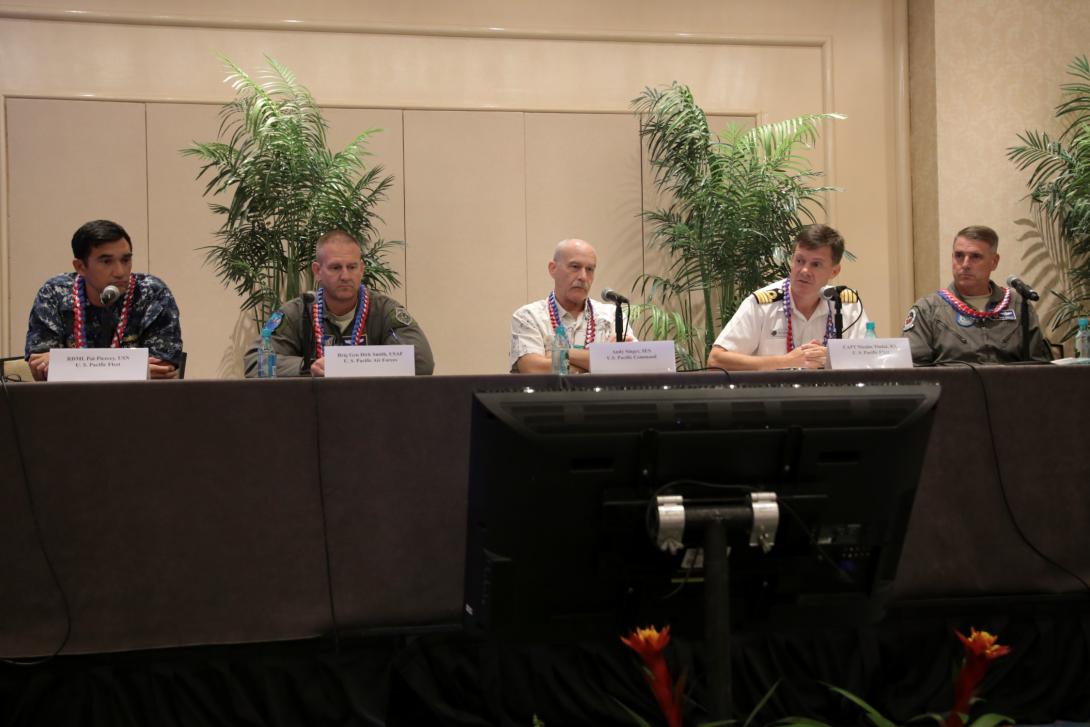Perils to Asia-Pacific Networks Lie Within
TechNet Asia-Pacific 2015
The SIGNAL Magazine Online Show Daily, Day 2
Quote of the Day:
“We came up with network-centric warfare when we should have had warfare-centric networks.”— Andy Singer, deputy director, intelligence, J-2, U.S. Pacific Command
It may not take a cyber attack by adversaries to impose severe network degradation on U.S. Pacific Command networks. The activation of those networks amid coalition operations may trigger failures arising from a lack of interoperability with allies and partners, and the effects could be as severe as if they were rendered by an enemy.
Even with best efforts to share technologies, U.S. communications and information systems are more advanced than even those of the most sophisticated allies. Many of the combat capabilities that U.S. forces rely on would not be available across a broad coalition preparing to enter combat, which would create weak links throughout the force. With any future military operation in the Asia-Pacific region likely to be a coalition action, fixing this problem will require extensive cooperation with allies as well as potential partners.
The theme of TechNet Asia-Pacific 2015, being held November 17-19 in Honolulu, is Fight to Communicate: Operating in a Communications-Degraded Environment. Wednesday’s opening speaker directly addressed that theme in his keynote breakfast address.
Gen. Vincent K. Brooks, USA, commander, U.S. Army Pacific, was blunt in his opening remarks about the perils of this interoperability challenge. “Before we have any contact with an enemy, we’ll find we have degraded communication,” he declared. “More often than not, we’re going to operate degraded before the enemy shows up.”
Being unable to exchange information effectively in a coalition will hamper U.S. forces in their areas of strength. Allies and potential partners shape the nature of the coalitions that will form. And, interoperability will require an international solution.
Col. Kristian Smith, USA, strategy and policy division chief, U.S. Pacific Command, pointed out that the United States cannot build strong coalitions without engagement. He declared that engagements are the integral ingredient to show that the United States is capable of building coalitions.
Yet even among close allies, the interoperability problem is significant. Gen. Brooks described how the Republic of Korea (ROK) forces have a command vehicle with two mounted displays: one for its own situational awareness system; the other a U.S. Blue Force Tracker system. Neither can exchange data with the other, so the ROK army needs to use both and rely on humans to consolidate their information on the move.
Gen. Brooks cited three different types of interoperability components: technical, procedural and human/cultural. All three must factor into developing interoperability solutions; no single component can solve the problem.
Yet human fixes can compound the problem of interoperability. “We have to be extraordinarily adept technologically—and we’re not,” he declared. U.S. forces must be able to interoperate with the least sophisticated partners, some of whom use what U.S. forces would describe as obsolete technology. “While we must be at the cutting edge [of communications], we must also maintain proficiency at the trailing edge.”
This issue is shared by staunch U.S. allies. “We don’t think ahead enough about a coalition environment,” offered Britain’s Capt. Nicolas Tindal, RN, who is posted to the U.S. Pacific Fleet. “It is no longer possible to operate alone. You don’t have the quality of knowledge” of local people and situations, he said in a panel discussion.
The Royal Navy captain agreed that a coalition operation already feels like a degraded communications environment. Citing examples in exercises, he noted that U.S. and British ships have no problem sharing information through CENTRIXS, which is designed to provide interoperability between close allies. However, as soon as combat began, U.S. ships would revert to using the Secret Internet Protocol Router Network (SIPRNet), which would leave only the British ships using CENTRIXS. As a result, neither fleet could alert each other to threats or other key situational awareness changes.
And this problem has been a long time in the making. Andy Singer, deputy director, intelligence, J-2, U.S. Pacific Command, offered his own view of the cause. “We came up with network-centric warfare when we should have had warfare-centric networks.”
Gen. Brooks asked industry to help close these interoperability gaps. He told them to ask themselves: “Is our technology built to connect us to anyone, anytime, anywhere?” That should be a criteria for developing new systems.
“We want to focus our attention on degrading our adversaries,” he said.
The threat of operating in a degraded communications environment has the U.S. Army Pacific training to operate with less than optimum capabilities. Gen. Brooks emphasized that the U.S. Army Pacific does not train to operate without any communications at all. The force must have some level of communications to operate. In training, the Army tries working with only limited communications. “We take out one layer of comms in exercises, and it hurts,” he allowed.
This training focuses on ensuring that commander’s intent reaches subordinate commanders in the force. On the topic of leadership, several panel members offered their own take on what constitutes good leadership in time of calm or crisis.
“The best leaders get out of their comfort zone,” said Col. David Moeller, USAF, commander, 613 Air Operations Center. Col. Jeff Davis, USMC, chief of staff, Marine Corps Forces Pacific, added, “Leadership is not for the good times; it’s for the tough times.” And Jodi-Ann Ito, information security officer, University of Hawaii, allowed that this dynamic era means, “We cannot afford to be afraid to fail, because we have to fail fast.”
On the final day of TechNet Asia-Pacific 2015:
Addresses by Lt. Gen. John A. Toolan, USMC, commander, U.S. Marine Forces Pacific, and Lt. Gen. Anthony G. Crutchfield, USA, deputy commander of the U.S. Pacific Command; and a J-6 panel on Fight to Communicate.
For complete coverage, follow #AFCEATechNet on Twitter and visit our coverage page.






Comments